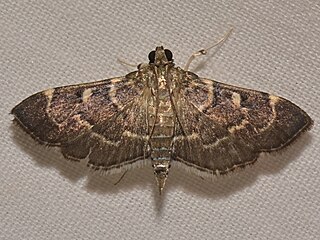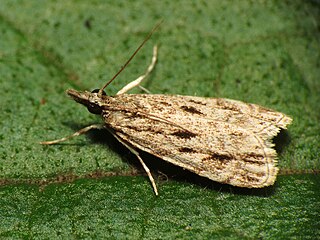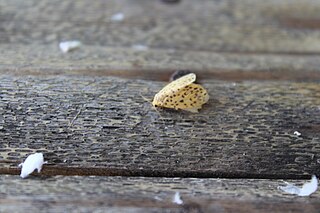
The Pyralidae, commonly called pyralid moths, snout moths or grass moths, are a family of Lepidoptera in the ditrysian superfamily Pyraloidea. In many classifications, the grass moths (Crambidae) are included in the Pyralidae as a subfamily, making the combined group one of the largest families in the Lepidoptera. The latest review by Eugene G. Munroe and Maria Alma Solis retain the Crambidae as a full family of Pyraloidea.

Cryptobotys is a genus of moths in the family Crambidae described by Eugene G. Munroe in 1956. It is monotypic, with its only species, Cryptobotys zoilusalis, described by Francis Walker in 1859. It is found in Cuba, Jamaica, Puerto Rico, Central America and the southern United States, where it has been recorded from Florida.
Hellula phidilealis, the cabbage budworm moth, is a moth of the family Crambidae. It is found in tropical and subtropical America. From the southern United States, north in the east to North Carolina, south through southwestern Mexico to northern South America, including several islands in the Caribbean.

Herpetogramma bipunctalis, commonly known as the southern beet webworm moth or two-spotted herpetogramma, is a species of moth in the family Crambidae. It is found from New England to Florida, west to Texas and north to Illinois. In the south, the range extends through Central America and the Caribbean to South America.

Vaxi auratellus, the curve-lined vaxi or curve-lined argyria moth, is a moth in the family Crambidae. It was described by James Brackenridge Clemens in 1860. It is found in North America, where it has been recorded from the eastern United States and south-eastern Canada from Quebec and Maine to Florida, west to Texas and north to Manitoba. It is also found in California.
Parapediasia ligonellus is a moth in the family Crambidae. It was described by Zeller in 1881. It is found in Jamaica, Cuba and Puerto Rico. It is also found in southern Florida.
Thaumatopsis pectinifer is a moth in the family Crambidae. It was described by Zeller in 1877. It is found in North America, where it has been recorded from North Dakota to Oklahoma, Texas and southern Florida, as well as Michigan and Indiana.
Trischistognatha pyrenealis is a moth in the family Crambidae. It was described by Francis Walker in 1859. It is found in Mexico, Central America, the West Indies and the southeastern United States, where it has been recorded from Georgia to Florida and from Alabama to Texas.
Dicymolomia grisea is a moth in the family Crambidae. It is found in North America, where it has been recorded from southern Texas to Florida and South Carolina.

Eudonia strigalis, the striped eudonia moth, is a moth in the family Crambidae. It was described by Harrison Gray Dyar Jr. in 1906. It is found in North America, where it has been recorded from Nova Scotia to southern Ontario and south to Florida.
Agathodes designalis, the sky-pointing moth, is a moth in the family Crambidae. It was described by Achille Guenée in 1854. It lives in Arizona, Texas, Florida, southern South America and the West Indies.
Microthyris lelex is a moth in the family Crambidae. It was described by Pieter Cramer in 1777. It is widespread in the Caribbean, Central America and northern South America. Records include Suriname, Puerto Rico and Jamaica. It has recently been recorded from southern Florida.
Diacme mopsalis, the mopsalis diacme moth, is a moth in the family Crambidae. It was described by Francis Walker in 1859. It is found in South America, Central America, the Antilles and the southern United States, where it has been recorded from Arizona, Florida, Oklahoma and Texas.
Ercta vittata is a moth in the family Crambidae. It was described by Johan Christian Fabricius in 1794. It is found in the West Indies and South America. It has also been recorded from Costa Rica and southern Florida.
Penestola bufalis, the black penestola moth, is a moth in the family Crambidae. It was described by Achille Guenée in 1854. It is found in the US states of Texas and Florida, as well as on the Antilles. It is an accidentally introduced species on the Galápagos Islands. The habitat consists of coastal mangrove swamps and shorelines.

Phostria oajacalis is a species of moth in the family Crambidae. It was described by Francis Walker in 1866. It is found in Nicaragua, Guatemala, Costa Rica., Mexico and the southern United States.

Polygrammodes eleuata, the red-spotted sweetpotato moth or many-spotted moth, is a moth in the family Crambidae. It was described by Johan Christian Fabricius in 1777. It is found in Central and South America, on the Antilles and in the southern United States, where it has been recorded from Florida.
Samea druchachalis is a moth in the family Crambidae. It is found in Mexico and the southern United States, where it has been recorded from Florida and Texas.

Samea ecclesialis is a moth in the family Crambidae. It is found in Argentina, Brazil, Bolivia, Colombia, Ecuador, French Guiana, Panama, Costa Rica, Mexico and the United States, where it has been recorded from North Carolina to Florida, west to Texas.
Sufetula diminutalis is a snout moth in the subfamily Lathrotelinae of the family Crambidae. It was described by Francis Walker in 1866 in the genus Isopteryx from material collected in Honduras.







